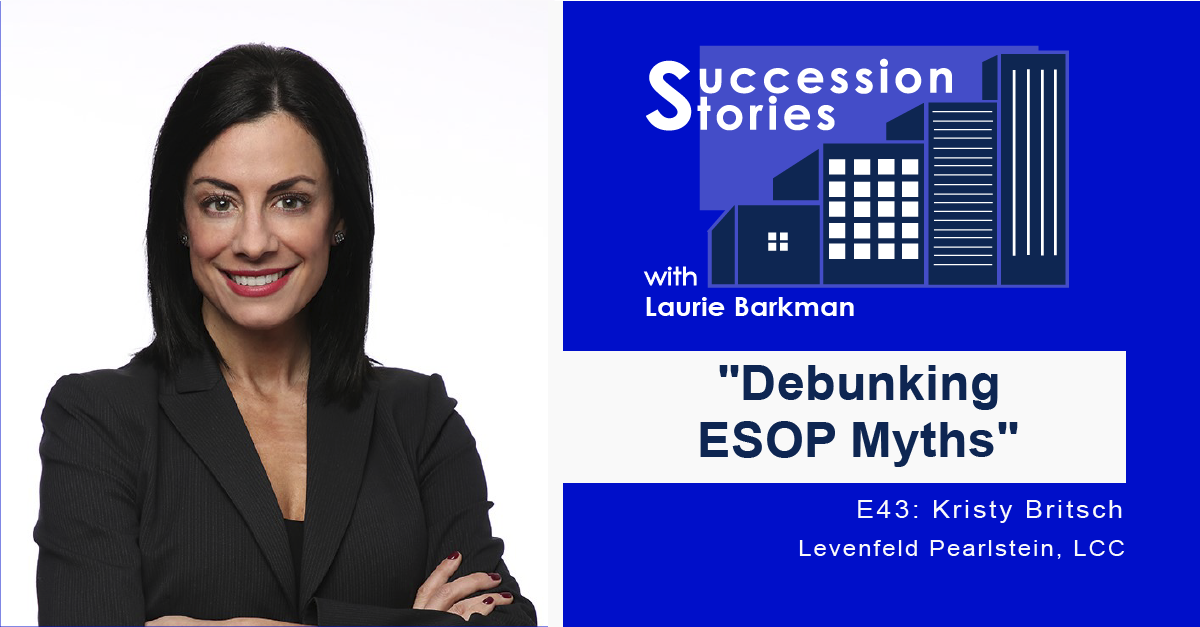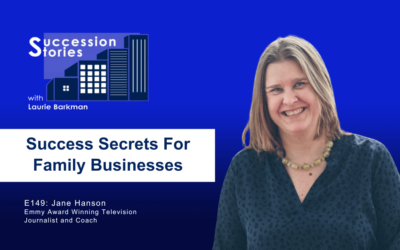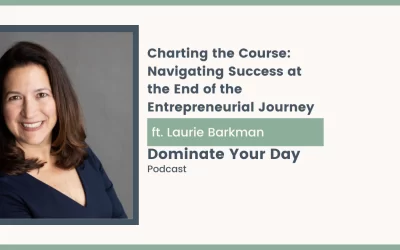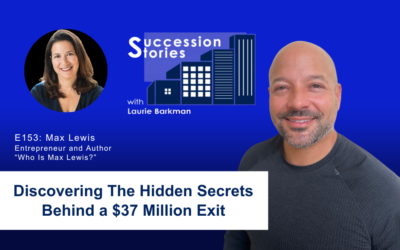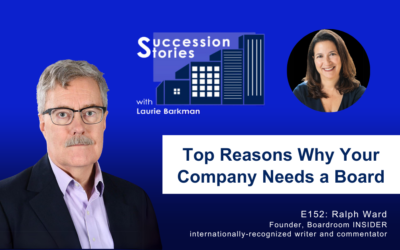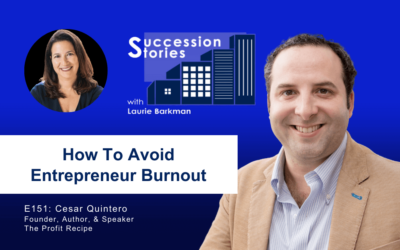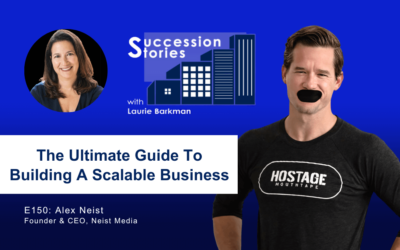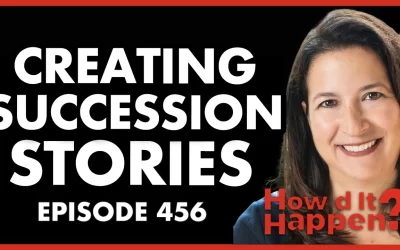Stream the podcast:
Watch the video:
When it comes to transitioning your closely held company, it’s great to have options. You’ve probably heard about strategic acquisitions – like Facebook buying Instagram – or financial buyers like private equity firms acquiring companies. Have you heard about ESOPs, employee stock ownership plans?
An ESOP allows employees the opportunity to buy stock in a closely held company to facilitate succession planning. Currently, there are around 7,000 ESOP plans in the U.S. with estimates that 28 million employees now control about 8% of corporate equity through an ESOP.
On Succession Stories, Laurie Barkman is joined by Kristy Britsch, senior counsel at Levenfeld Pearlstein. Kristy advises closely held businesses on ESOPs and helps navigate transactions and legal aspects that can arise during its life cycle.
Being part of an ESOP can provide numerous benefits to employees and the company. There are, however, several myths regarding ESOP ownership, preventing exploration of this compelling option.
Listen in to Laurie’s conversation with Kristy to learn what an ESOP is (and isn’t) and how your company shareholders might benefit.
Show Notes:
Listen in to learn more about:
- How companies incorporate ESOPs into business succession planning
- Examples where an ESOP may be a good solution for succession planning, and examples it may not be a fit
- Complexities related to an ESOP stock purchase transaction
- Issues that can arise during the life cycle of the ESOP post-transaction to avoid
- Best practices for CEO compensation in privately held companies
Show links:
Kristy Britsch: linkedin.com/in/kristybritsch
Levenfeld Pearlstein Website: lplegal.com
Subscribe to Succession Stories and get all of the latest episodes.
Please show your support with a rating and review!
To connect with the host, Laurie Barkman, visit https://www.smalldotbig.com/contact
Episode transcript:
Welcome to Succession Stories insights for next-generation entrepreneurs. I’m Laurie Barkman. I’ve spent my career bringing an entrepreneurial approach to mature companies struggling with change. As an outside executive of a third-generation 120-year-old company, I was part of a long-term succession plan.
Now I work with entrepreneurs privately held companies and family businesses to develop innovations that create enterprise value in transition plans to achieve their long-term goals.
On this podcast, listen and while I talk with entrepreneurs who are driving innovation and culture change, I speak with owners who successfully transition their company and others who experienced disappointment along the way. Guests also include experts in multi-generational businesses and entrepreneurship.
If you are a next-generation entrepreneur, looking for inspiration to grow and thrive, or an owner who can’t figure out the best way to transition their closely held company, this podcast is for you.
Subscribe to our newsletter for more resources to build value in your business, visit smalldotbig.com and sign up today.
Laurie Barkman:
When it comes to transitioning your closely held company, it’s great to have options. You’ve probably heard about strategic acquisitions, like Facebook buying Instagram, or financial buyers like private equity firms acquiring companies. Have you heard about ESOPs (Employee Stock Ownership Plans)? An ESOP allows employees the opportunity to buy stock in a closely held company to facilitate succession planning.
Currently, there are around 7000 ESOP plans in the US with estimates that 28 million employees now control about 8% of corporate equity through an ESOP. My guest Kristy Britsch is Senior Counsel at Levenfeld Pearlstein. She advises closely-held businesses on ESOPs and helps navigate transactions and legal aspects that can arise during its lifecycle.
Being part of an ESOP can provide numerous benefits to employees and the company. There are, however, several myths regarding ESOP ownership preventing exploration of this compelling option. Listen in to my conversation with Kristy to learn what an ESOP is and isn’t, and how your company shareholders might benefit.
Kristy Britsch, good morning and welcome to Succession Stories. I am looking forward to this conversation. The topic of ESOPs has come up a couple of times on this show and while some people might know what ESOPs are, and the benefits of them, and the challenges of them, some others might not. So you are an expert in ESOPs, you have a lot of experience in your law practice, and putting them together with companies. I am so excited that you’re here on the show with me today, so welcome.
Kristy Britsch:
Thank you for having me. Happy to be here.
Laurie Barkman:
Why don’t we start by talking about you. Tell us about you and your background.
Kristy Britsch:
Born and raised in Pittsburgh, when I graduated high school I moved to Columbus, Ohio, and went to the Ohio State University. Did undergrad at Ohio State, I went to Capital University for law school, which is a private school in Columbus. When I graduated from Capital I stayed in Columbus and ended up living in Columbus for a total of 20 years before I moved back to Pittsburgh in 2016. Started my career in Columbus, started out actually with a solo practitioner who represented companies who were ESOP owned companies, and fresh out of law school I had no idea what that was. I had some experience with ERISA – more of the fiduciary compliance that goes along with an ERISA fiduciary – but really no experience with ESOPs at all.
Funny thing, when this attorney hired me, it was in October, and anybody who does transaction work knows that the fourth quarter and December in particular, are just crazy. No sleep, purely adrenalin closing year-end deals so when he hired me, I just got thrown into an ESOP transaction world but at that firm, I did a lot of risk and compliance work – so obviously representing ESOP owned companies – did the transaction, got thrown into the fire so hopefully, I did a good job on those. From that point on, it was more of the compliance, so keeping the ESOP to date with IRS or Department of Labor regulations.
We had a lot of clients that came to us for executive compensation-type matters, which usually go hand in hand with ESOP 401k compliance, so I was an ERISA geek for the good part of my early career. His firm was then acquired by a regional firm in Columbus and they did not have an ERISA practice. Their corporate group – they have a very large corporate group. – they were getting a lot of inquiries about ESOPs; they just didn’t have anybody there that did them. Tim and I went and met with them. It was just a good fit for him and for me, and we joined that firm. I ended up staying there for close to five or six years doing additional ESOP transaction work, but then also doing more of the executive compensation, and more of just general risk compliance. I was helping their existing clients draft 401k plans for profit-sharing plans, cash balance plans, and defined benefit plans. so the whole gamut.
After I left there, I joined a larger national firm and expanded my ESOP practice by doing that. It’s funny how your career morphs over the years, but I started doing probably more ERISA compliance, so working with other plans that were just ESOPs, and then as I was maturing in my career, I was getting more referrals for each transaction work, and highly enjoy it. I love working with the business owners to set those up and the ongoing work that comes with it. Yeah, so I stayed at that firm for another five years, and then lo and behold when I left that regional firm – and it’s actually how I came back to Pittsburgh – I went in-house and was working for an ESOP trustee. Unfortunately, that ESOP trustee is no longer in the business, but it’s a large institutional trustee and in that role, I was the trust who was buying the stock from the selling shareholders who were selling to an ESOP. I had that role for two years before they got out of the business. That position, though, did bring me back home to Pittsburgh. My whole family’s here so it was nice to be back.
The current firm that I’m with is a Chicago-based regional firm, although our ESOP practice is national. We have clients all over the place and we travel quite often to go see them and to go see referrals. They were gracious enough to embrace remote working before it got forced upon us so I work with my colleagues here in Chicago, but like I said, our clients are everywhere. We traveled to see them at conferences, referral sources, so we’re out and about everywhere.
Laurie Barkman:
Awesome. Well, that’s a great overview of your background, because you talked about the employee stock ownership plan piece, as well as the employee benefits and exec comp so that’s a great overview. Let’s talk specifically about ESOPs. What does that mean? What does it mean from the opportunities and how companies are incorporating ESOPs into their business succession planning?
Kristy Britsch:
In ESOP, and it’s quite funny when you say ESOP, it’s an employee stock ownership plan, it’s not to be confused with an employee stock option plan, which is a form of executive comp. I sometimes get phone calls that somebody wants to set up an ESOP but they’re really wanting to do a stock option plan.
But an ESOP is an employee stock ownership plan, essentially, a qualified, defined contribution plan. For owners that know how a 401k plan works, an ESOP is going to work very similar to that. It’s a qualified retirement plan that has to comply with IRS requirements. It’s a way to transition the business to the employees in a beneficial way.
What that means is employees — there’s a legal shareholder in an ESOP, and that’s the trust. When we’re selling to an ESOP, people think, “Are my employees actually getting stock?” The answer is no. There is a legal trust that will be buying the stock from the selling shareholder. The stock certificate after the transition occurs is in that trust’s name. Your employees are what we call beneficial owners. At the end of the transaction, you’re left with this qualified retirement plan.
Again, it’s going to operate very similarly to a 401k. Your employees have accounts, the plan is invested primarily in company stock but whenever an employee has a distribution event, meaning they retire, become disabled, have a disability, or if they just quit or get fired, whatever the reason is, they have a distributable event at that time, and in most cases, they’re going to get the cash so it’s not like they walk off with stock of the company and have a stock certificate. There’s ways around that. That’s a little — like we can talk about that — it’s a little more technical, but they’re getting the cash benefit.
The other unique thing about an ESOP is it can borrow money. A 401k, for example, cannot borrow money. An ESOP can borrow money, and that money is used to purchase additional stock, which then helps to fund an employee’s retirement account within that ESOP. ESOPs also are, again, invested primarily in stock. That’s a little difference between a 401k and an ESOP but again, it is a retirement plan. I like to reiterate that to owners because it’s not as if you do this transaction, and then suddenly, there’s nothing to worry about on an ongoing basis. Again, it’s not an option plan; employees don’t buy into this. In a stock option plan employees have to come up with money to buy into the company. That’s not what this is. The employees do not contribute to an ESOP; it’s strictly employer contributions that are made in cash or stock.
Laurie Barkman:
So I’m a founder, and I am a 100% shareholder of my company. I’m envisioning having a transition at some point to retire, and I don’t have any other family members that are in the company. Why would an ESOP be something to consider?
Kristy Britsch:
That’s a good question, and it fits in with, “What does the owner want?” This also goes to the question that we sometimes get; “Are ESOPs bad?” There’s a lot of misnomers and we call them ESOPs Fables that go with this. If an owner is looking to transition the business, regardless if there’s family members in the business or not, what are the owners objectives? This is where his team of advisors or her team of advisors are going to become very integral because when you’re looking to sell there’s a financial and a strategic buyer. An ESOP is an option of a financial buyer.
What would make that different than selling to a third party? Well, think about a business owner if they’ve grown this company to what it is and now here they are, it’s their legacy. They’re wanting an exit plan. What do they want to do with that? Sometimes business owners are apprehensive to sell to a third party, that they don’t know what’s gonna happen with the business after the sale? What’s going to happen to my employees? What is the culture, this legacy that I built in this community for this business? What is the legacy of my business? If those are questions that somebody is asking, then any thought may be worth a talk with that person, maybe an owner wants to gradually leave the business. They’re not saying, “You know what, I want to sell my business, take my money, I’m going to retire on an island.” If that’s what they want to do, maybe an ESOP isn’t a good fit, but if they say, “I’m not in any hurry to leave, I see my exit plan and let’s just say five years from now, or maybe three years from now, or maybe longer,” then an ESOP would be a good discussion point. Do they want to maintain equity in the business for their employees? Some business owners that have family members, they want to keep the business going for the family but some of our companies that are ESOPs that don’t have family members in the business, there are some employees that helped grow this from nothing and they want to make sure that they’re rewarded, and they want to make sure that they’re taken care of.
When there’s a culture and a mindset of, “What’s going to happen to my employees, what’s happening to my legacy, what’s happening to my business, I’m in no hurry to leave, but I want to start thinking about that,” those are good ESOP candidates and that’s just it’s just a discussion to have. It’s not saying that it may or may not be a good fit after we go through all the discussions, but it’s at least something to put on the table as an option. There’s a lot of tax benefits that go with selling to an ESOP, if the business is a C Corp, the owner can what we call a 1042 election. It’s the tax code 1042. They can make an election under that tax code and defer capital gains treatment. If they sell to an ESOP but at least 30% as a C Corp. If they’re an S Corporation, there’s only one — you’re selling to an ESOP as an S Corp, and if you’re 100% owned by an ESOP you pay no federal or state taxes so there’s a lot of benefits. If you’re a C Corp, if you’re an S corp, what’s your horizon as an owner? Again, some people say, “I just want to exit, I want to leave. I don’t want to deal with ongoing expenses.”
Because when you do form an ESOP there are ongoing matters that business owners just need to be aware of. It doesn’t make it a burden. It doesn’t make it complicated. It’s just something to realize that when you go through this ESOP sale; there is ongoing work after the sale, it holds employer securities, so it has to be valued on an annual basis, at least to determine what is that value of the stock. You’re gonna have a valuation firm doing that, which is an expense. If you have an outside trustee, there’s an outside trustee expense. Some companies, if they have a corporate attorney, they may bring in a special ESOP attorney just to help with the ESOP-related things on a going-forward basis. So there’s just some expenses that happen after the sale that we just like owners, we don’t want you to be caught off guard if you decide to do this. Then you say, “Wait, I didn’t know that I had to do this ongoing valuation, or I didn’t realize that there’s a third-party administrator that needs to administer this plan,” but that’s another expense. There’s a lot of factors such as what are your immediate goals? What do you want to get? And then ongoing, is this a right fit?
Laurie Barkman:
Just to recap that. The owner is essentially selling the shares of the company to the trust. The trust then has an administration and costs associated with the ongoing maintenance of that including things that you mentioned and so if you’re in the company, and you’re, let’s say an outside CEO that’s come in, and it’s there’s an ESOP structure, then that CEO is, I guess, Administrator of the trust. Is that how it works?
Kristy Britsch:
No, so I guess I’ll back up. When you’re forming an ESOP it’s just like any other M&A transaction, so it’s not any more expensive. Any owner that’s ever gone through an acquisition, whether they purchased a company or whether their company may have been purchased, at some point, the ESOP transaction is going to operate that same way. The only difference is, the person buying your stock is an employee stock ownership trust; it’s a trust that a trustee oversees.
Whenever you’re doing a transaction, it’s recommended that you hire an independent trustee. There are many people that we work with around the country that serve as an ESOP trustee. When you’re going through the transaction, you have usually an outside independent trustee serving as the trustee of this trust. They’re an ERISA fiduciary and their goal is strictly for the ESOP participants so they need to make sure that the ESOP trust that’s buying the stock from the owner is not paying more than fair market value.
After we go through that process, depending on a client or a business owner’s appetite and what they’re willing to do for expenses, they can keep that trustee on as the trustee for ongoing, or they can appoint somebody internally so that most of the risk for ESOPs is at the transaction level. For that reason, you want an outside trustee; they could hire, they could put somebody internally on as a trustee after the transaction. Most of our clients don’t do that. There’s nothing wrong, for anybody listening, that may have an internal trustee but when you’re doing a transaction, any transactions involving that stock in that trust, it would be recommended that you get an outside trustee.
If somebody, for example, anybody – doesn’t matter if it’s the CEO or just another employee – if you’re an ESOP company, and you hire somebody, they are going to become a participant in that ESOP based on how the plan is designed so I guess look at it two-fold. There’s the transaction aspect of an ESOP, and then after that transaction is done, you have a plan, so it’s going to be similar to the 401k. Again, when do you enter the plan? What’s the eligibility requirement? How do you get allocations of stock or cash into your account? When do you get a distribution? How do you vest? Those types of things are in the plan document so anytime somebody is hired, whatever their position is if they meet eligibility requirements, and they’re an employee, and not otherwise excluded, they’re going to enter that ESOP.
The ESOP is administered on an annual basis so every year. I’ll just keep it simple. December 31 is your plan year or the plan’s accounting date so every December 31, the third party administrator is going to do the ESOP accounting, they’re going to see who’s entered the plan, who may have left the plan, who’s getting allocations, who’s vested, what percent vested who’s getting allocations and how much stock or cash are they getting? That’s how the stock grows.
After the transaction, and I know it can get a little confusing, but after the transaction, there is a plan document that governs these more administrative, technical things. The other thing that can get a little technical is there’s usually an internal ESOP loan between the company and the trust. Because when the trust is buying stock from the owner, the trust doesn’t have cash to buy the stock so the company loans the cash to the trust, and the trust then pays it back. It’s a very circular way of thinking.
That ESOP alone – I’ll just throw out an easy number, 30 years – if an ESOP loan is 30 years, that means the company for 30 years is required to make a contribution to the ESOP for X amount of dollars every December 31 for 30 years. That’s how – we call them allocations – that’s how stock or cash gets allocated to accounts. When somebody gets hired and they enter the ESOP, they’re gonna say, “Well, how am I getting stock or cash?” The answer is, the company has a loan with the trust; the company is going to make a contribution. That contribution is tax-deductible as it would be with any retirement plan, and then it’s going to get allocated to accounts of participants. That’s how you get money in your account. So the CEO in your example, he would be a participant in the plan, not necessarily a trust trustee.
Laurie Barkman:
Gotcha. So the owner at the time of the transaction when there’s that conversion into the trust is the owner receiving payment for the shares?
Kristy Britsch:
Yeah, and there’s a couple of ways that that can be structured. When the owner is selling to the trust, the trust can pay him. Usually, it’s not done this way, but the trust is gonna pay him maybe a portion in cash, very seldom would it be all cash. The reason is because part of that purchase is going to be made maybe in cash, it could also be made in the form of a seller note.
The way that that structure would work is — and it depends — we could structure this different ways but essentially, at the end of the day, the selling shareholder is going to sell their stock to this ESOP trust, they may get a cash portion of payment. But in most cases, they are going to take back a seller note and that’s going to be at a negotiated interest rate at a negotiated term. That negotiation process is part of the ESOP transaction. That’s the negotiations that happened with the selling shareholder in the company, and their ESOP counsel.
On the other side of the table, you have the ESOP trustee who has their own counsel and their own financial advisor so it is when you’re looking at the transaction, and what is the selling shareholder getting? What’s the purchase price, and in what form is that purchase price coming to that owner, cash or a seller note, maybe all seller note. There’s other ways that an owner can get paid, they can get what we call warrants that are attached and seller note. That gives them a little more equity in the business.
One of the other things that we sometimes negotiate as part of these transactions is the selling shareholder owns the stock, so they’re getting the benefit of the purchase price. They’re getting the benefit of a seller note at some negotiated interest rate over a certain amount of years. They may be getting warrants with that. So sometimes a question arises as to what about my management team? They’ve helped me build this business, they don’t own stock to sell so how do I make them get on board with this ESOP? One of the things that we do to the executive comp issue, we usually set up what we call stock appreciation rates plans (SARs) is what we call them. A SAR plan can be in the form of a performance star or a retention star. Usually, the selling shareholder does not participate in those plans, because they’re getting their benefits elsewhere, through a seller note and through warrants, and through selling the stock.
Usually, we structure a SAR plan in conjunction with any stock transaction, so that management, or any other key employee that the owner wants to feel, as a part of this and feel like they’re really getting something, we’ll set up a SAR plan. Again, it’s negotiated with the ESOP trustee, and their attorney, and their financial advisor. That’s giving some additional benefits outside of the ESOP to keep people that you want to keep. Because at the end of the day, an ESOP is a retention tool. It’s also a recruiting tool.
There’s a lot of studies out there that if you look at performance and ESOP companies, they tend to outperform their competitors. When you think about an ESOP company, it’s invested in employer stock, that market is your company. The more that employees and the more that management feel that they’re really getting something of value for this business, it makes everybody work harder. It makes them proud. I mean, there’s some clients, some businesses that you might walk into, and they’ll say, “Hi, I’m an owner,” and it’s their employee, but they’ll feel an owner so it’s a good retention tool, a good recruiting tool, and those SAR plans, if you’re hiring — you asked earlier about the CEO — if I’m a CEO, and I’m coming to this business, and they’re an ESOP, I might say, “Well, because I’ve been an ESOP for a while stock has already been allocated in the ESOP itself what else can I get?” You might say, “We have this. Our plan, retention, and performance are based on the company’s performance, you might get some SARs every year. The longer that you work here, you might get some SARs based on years of service.”
There’s a lot of ways to recruit with the ESOP, not only the ESOP itself, because it’s another retirement plan; it’s another employee benefit that the employees aren’t paying for. They’re not contributing to it so it’s a pre- benefit but there’s also what we call SAR plans so when we design these ESOP transactions, we keep in mind that there are going to be people that as the ESOP matures, down the road you’re going to hire you’re going to want to hire new management or new talent. Not even if it’s management may be a great salesperson. These are vehicles that we use to keep the people that we have that we want to keep, but also to bring new people in and again, that are not a selling shareholder. It still gives them an equity interest in the company through the ESOP itself and then through the SAR plans, for example,
Laurie Barkman:
Right. Kristy, you did a great job of explaining how this could benefit. There’s so much here I feel like I’m getting a one on one. Then like a 301. At the same time, I got a graduate class. This is amazing. I like how you’re describing the type of company where it might be a great fit. I like how you’re talking about why they might want to pursue. Can we look at the other side? Which is why would this not be a fit for a company?
Kristy Britsch:
One, and again, it goes hand in hand somewhat with ‘why is it a good fit?’ If you have, I’ll just use an example, if some advisors are pushing an ESOP on a business owner, if the business owner says, “Listen, I want to sell and be out, I don’t want to stick around, that’s not going to be a good fit.” If a business owner sold out and didn’t understand that, “Hey, you might get a seller note so you might want to stay in the business for a couple of years because if you have a seller note, the company owes you money for your purchase,” you want to stay in that business, at least until the seller note is paid off because you want to make sure that the company is performing well.
Whenever a business owner is exploring options, you know, full disclosure is the best, there should be no surprises. Like I was saying, some companies may do a nice job, and they may not understand that there’s an annual evaluation that you need to do every year and there’s a cost associated with that. There’s a record keeper that needs to do all of the administration and that’s an additional cost. If you have a 401k plan you’re going to be doing…you have two plans that are being administered so some ESOPs go awry when the way that they operate ongoing isn’t really fully disclosed.
We have some clients that have come with us over the years and sometimes there’s things that they just didn’t understand or just didn’t know, it happens, but you never want to advise a client and have them not understand the full big picture, because that’s not going to make anybody happy at the end of the day. Some other issues where it might not be a good fit. If a company has, let’s just say a customer concentration issue so there is one customer that pretty much makes up all of their business, when the trustee and the trustees’ financial advisor are valuing the business that is going to take into account the customer concentration issue, it may make the company have a little bit of a lower value than they would if they sold to somebody that’s not an ESOP.
Another issue is industry. Maybe the industry is just not performing well. I remember a time when the oil and gas industry was booming, and then it wasn’t, and it may not be a good fit at that time. If you’re in the oil and gas business, I’m not picking on that industry, I’m just using it as an example that maybe it’s not a good time to sell to an ESOP because you’re not going to get a maximum value, so you want to take into account, “What industry am I in? What does my customer makeup look like?” Another thing to think about is, “What are my cash flows? Do I have a historically strong cash flow? Is my revenue increasing or are there years we’re years where things are going down?”
It may be that that might not be a good fit at that time. It’s not to say that it’s never a good fit, but when a business owner is exploring an ESOP, there’s a lot of things that need to go into this analysis. It’s me as an owner, “What do I want? What is the culture of the business? What do I want the legacy of the business to be? What do I want to give back to family if the family’s there or to the employees?”
Aside from all of those types of things, you need to look at, “What industry am I at? What does my business look like? Did we have some down years that are going to affect the value of the business when the trustee and their advisors are looking at what’s the value of my business?” Things like that are things that business owners should keep in mind.
Again, when they’re working with their advisors, the team of advisors usually consists of the accounting firm or their CPA, their lawyer, sometimes if they have a strong banking relationship with somebody that knows the business, but these trusted advisors that the business owner has are really great resources for them to say, “What are the risks? What are the cons? What are the pros? Is this a good time for me to transition my business end to anybody? Or should I wait? And if I do, what does that look like?” At that point, there’s a lot of — we call them feasibility studies — but at that point, advisors usually do an analysis of the business and say, “Is this financially feasible for you and what does it look like?”
A really great way for a business owner to understand if an ESOP would work is to see, “If I sell my business to Company A, Company B, or this ESOP, what do these three look like?” When you model that out financially, an ESOP has, like I said, there’s some tax benefits that go with selling to an ESOP. If you’re a C Corp, you can defer capital gains if you sell to the ESOP. If you’re an S Corp, you pay no federal or state income taxes for the part of the business, it’s owned by the trust by the ESOP. All of those things factor into if it’s a good fit or not but again, the company needs to, and it’s with any sale, not just an ESOP, make sure that you know, historically the company is performing well, strong cash flows.
One of the other things that’s important is management. As a business owner is thinking of transitioning the business hand in hand with that is, well, “Who’s my management team? Who’s gonna take over when I’m not here?” That’s a very important aspect. Whenever a business owner is sitting in a due diligence meeting with an ESOP trustee, that’s one of their questions. “If you get hit by the bus, who’s gonna step in? If you get hit by the bus or all of your clients gonna leave? What does that look like?” The business owner needs to have strong management, they need to have their internal succession lined up. “if I get hit by the bus, they know Joe Smith over here, and he’s going to take over and it’s not going to be a problem.” The company just needs to get itself ready to be sold. Making sure, again, that management is in place; succession management, financially, it’s stable, and, making sure that it fits with the culture of the business, and it’s what the owner wants. There’s a lot of things – emotional and economic – that go into, “Is this a good fit for me?”
Laurie Barkman:
Those things that you mentioned, in terms of the planning and the exit planning side, are not uncommon for valuing a company like you’re saying to a third party, the customer concentration, also, I would probably add to the list the differentiation in the market and there’s a recurring revenue model – you talked about cash flow – so all those factors, what I boil it down to is, usually there’s eight key drivers. You talked about a number of them which is awesome.
For anyone listening, all of those things, whether you’re going to do an ESOP, or whether you’re going to sell to a third party, whether you’re going to transition to family, and you’re valuing the company, or a third party looking at your business, it’s good to look at all of those factors, and then Kristy, as you said, making that determination of what’s the best fit. That’s really where it comes back to what are the objectives of the owner, and some of those other considerations. You mentioned that there can be post-transaction challenges, and so you work with clients on post-transaction. What types of issues do you try to focus on to help them avoid?
Kristy Britsch:
This could be a whole nother series. After the transaction, the first couple of years of the ESOP, because it’s new, the company is diluted because it took on debt to finance this transaction. As the company pays off debt, as the stock matures, as people start getting a meaningful benefit in their account, they’re becoming vested after three to six years turning out that example. The ESOP starts becoming meaningful. Some of the issues that we see are after the ESOP starts growing. Usually the first five years, it’s pretty quiet. The company’s paying off debt, everybody’s happy they’re still communicating it to the employees and trying to help everybody understand what this is, and what’s the benefit of it.
Some of our more mature ESOPs run into what we call a have-not issue. As I mentioned, and I tried to keep it simple but it can be a little technical of a topic, but when I was mentioning that there’s an ESOP loan between the company and the trust, that loan is what dictates the company’s contribution every year. Again, it’s a tax-deductible contribution, but that contribution is what allocates stock or cash to accounts. Some of our more mature ESOPs say, “Well, I don’t have a loan, it’s paid off, but I’m hiring new employees. They can’t get any stock. So what do we do?” There’s a few things that you can do. The company can really leverage itself and do another transaction to get more stock into accounts- we call them the have-nots because these are employees that are coming on board that are fairly new to the company. They didn’t have the benefit of when the stock was first established so we need them to feel a part of this ESOP; it’s a culture. That’s one of our challenges; how do we address the haves and have-nots issues? How do you get stock to accounts of employees that are fairly new to the business but you have a very mature ESOP and your ESOP loan is paid off? How do you address that? That’s one of the things that we see.
Some of the other things that we see are corporate governance issues. Sometimes — and this happens, again, as the board composition changes — maybe the ESOP was done in an era where we didn’t really — so when we do enough transactions nowadays, in the last few years, we usually structure the board to what we call a nomination committee or a compensation committee or an audit committee. That’s basically the board of directors delegating some of its duties to another group of employees or board members or management, whoever is on that committee. Some companies don’t have those sophisticated setups and it can cause some confusion among the board about who is selecting the board because if you think about who selects the board members, it’s the shareholder and that’s the trust. Sometimes we see very mature ESOPs that the board is not the same as it was when you did the ESOP back in the early 2000s. To help educate, I guess would be the word, management, and the board on “What does an ESOP corporate governance model look like? What is everybody’s role?” Explaining those sorts of things is sometimes challenging, but it is one of the things that we see, again, when we do transactions nowadays, and this is partly because a lot of the Department of Labor scrutiny that is on ESOP transactions.
They’re structured to address these things, to avoid them from happening down the road, but we have a lot of clients that – some are from the 90s, some are from the early 2000s – and that group of people that were there when this ESOP was set up or not there, so it’s educating them, “This is how this works. This is what it looks like. This is how corporate governance works within an ESOP.” There is a shareholder that’s a trust. The trustee votes on stock. For example, if a company would ever undergo an asset sale participants vote, so there are some pass-through voting matters that participants statutorily need to vote on. Their voting is limited to the stock that’s allocated to his or her account. But until some companies go through that, like, “Hey, we’re going through an acquisition, and it’s going to be an asset sale. Well, we have to pass through the vote to the participants,” some people don’t realize that so that’s an educational challenge. Those are, I guess, those are good problems to have. It just takes some education and a lot of patience and a lot of talking, but there are good things to happen.
Laurie Barkman:
Well, that’s true. Just like with any complicated matter, an ESOP certainly would fall into that category. You’ve done an awesome job today of describing what is an ESOP, why a company might want to look into it, at its core, how it works, and I really appreciate that you’re clearly an expert. If people want to find you online to learn more about what you do and how you work with companies, what’s a good way for them to find you?
Kristy Britsch:
Probably my email. It’s kbritsch@lplegal.com. I’m on LinkedIn, so you can always look me up on LinkedIn.
Laurie Barkman:
Okay, great. Like I said, I’ll put that in the show links, and, last question for you, Kristy is if you have a favorite quote, about entrepreneurship or leadership that you’d like to share.
Kristy Britsch:
This goes back years ago to an ESOP of mine and it fits with an ESOP culture. I remember him saying at a due diligence meeting that he wanted to do one and somebody said, “Why do you want to do it?” and he said – and this was very fitting for what I do, and I think for even if you’re not an ESOP company – he said that, “Leadership is not a title or a position, it’s an action and an example,” and that always resonated with me. People can have titles and positions but actions and the example that you set speaks sometimes louder than that or does speak louder than that. That’s something that’s always resonated with me. That particular company is a very successful ESOP company and I think it went from the leadership down.
Laurie Barkman:
That’s a great quote. Thank you so much, Kristy, for being on Succession Stories today and sharing your expertise with us about ESOPs. Really appreciate it.
Kristy Britsch:
Thank you for having me. It was fun to be here.
Laurie Barkman:
Innovation, transition growth. Easy to say but hard to do.
If you’re an entrepreneur facing these challenges. I get it. I work with businesses from small to big for strategic planning with your team to achieve your vision.
Visit smalldotbig.com to schedule a call with me. I’d love to connect with you.
Be sure to catch the next Succession Stories episode with more insights for next-generation entrepreneurs.
Subscribe to Succession Stories and if you enjoy the show, please share a rating and review.
Thanks for listening.

